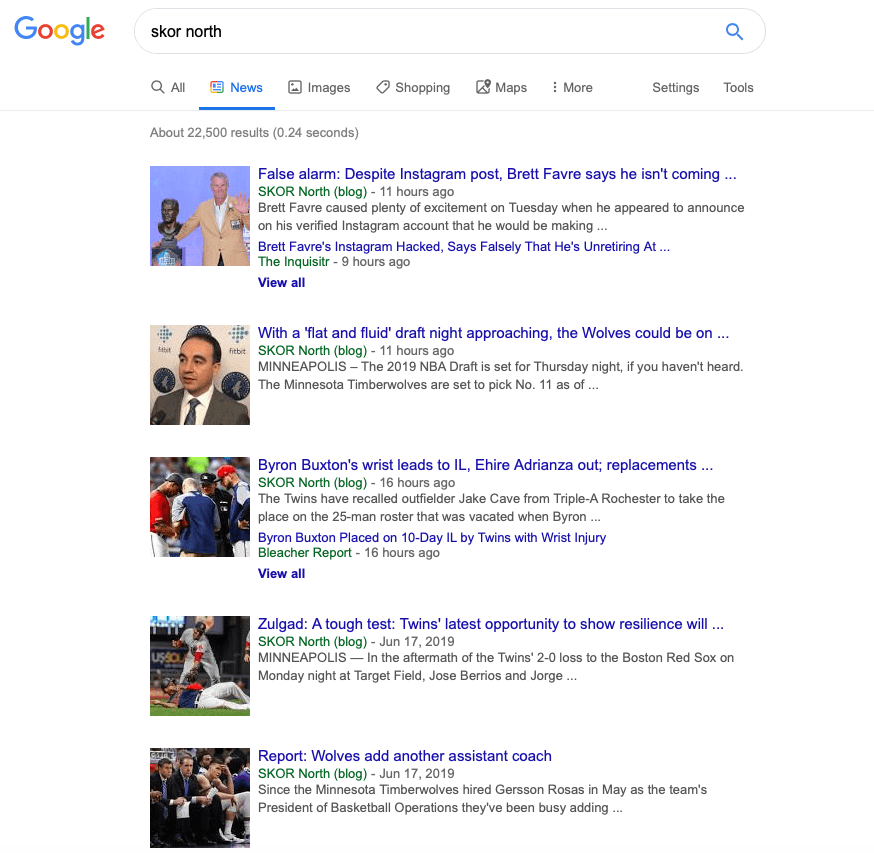It’s a simple question that doesn’t have a wrong answer, but you’re sure to find that many different stations have many different philosophies. Some stations take it very seriously and hire staff that exists solely to provide online content such as blogs, news articles and opinion pieces. Others put little emphasis on it and use it solely as a tool for people to listen online.
Regardless of your station’s philosophy, you website can still be an effective tool to help drive more content, listeners, and most importantly, dollars for your station.
For example, take a look at what SKOR North in Minneapolis is doing. This is a brand that’s putting a lot of effort into its online content. In turn, the station has found a way to make the website profitable by putting out content that’s both local and original.

“It’s less about being a news source and more about creating a website that specializes in being a destination for Minnesota sports fans — for audio, video and written content,” said program director Phil Mackey. “Our goal is to entertain and inform Minnesota sports fans in as many ways as possible. The website is our main hub.”
Selling digital space is still something, we, as an industry, are trying to fully grasp and figure out. But SKORNorth.com seems to have a solid strategy of how to profit off the content they’re putting online. Let’s remember, good content is great, but there still has to be a way to make it profitable.
“We have found a very good stream of digital revenue,” said Mackey. “But I think the mistake companies make is de-emphasizing platforms that don’t generate revenue directly. If you can build a large audience on a lesser-revenue platform, there’s still a good chance that audience will spill over into the platforms that DO generate more dollars.”
The Horn in Austin, Texas is currently revamping its website. Though the locally owned station gets a ton of online hits from people around the country wanting to hear about the Longhorns, program director Erin Hogan wants to put more emphasis into what the station is putting out on the web. That includes more content put out by the on-air staff, but it also means a unique approach to how the stations deals with live reads.

“One of the things, programming wise, that we’re looking to do is stream line our live endorsements from our on-air staff,” said Hogan. “We’d like to be able to shorten the live spot and say…hey, we’re telling you about a certain car dealership, check out hornfm.com and you’ve got the brand new Ford F 150 and you can check it out there, as well as videos behind the scenes with the clients that really drive people to the website. I think all businesses are looking to be more digital and that’s what we’re trying to do. We want to create less commercial time on our local shows but also use the power of digital to offset that and be a more powerful branding message for our clients.”
I’m a firm believer that terrestrial radio is always going to be important. No matter what the trends say, at the very least, people are always going to be in the car during their commute to and from work. However you also can’t ignore how easy it is with smartphones to listen to a station’s content with the simple push of a button.
Big market, medium market, even small market radio stations have some sort of app that serves as a live stream to the listener. But the majority of the time I go to a website, I’m doing so in hopes of finding an easy way to listen live to that station’s content. Articles, pictures and ads make a station’s website look great, but don’t undervalue the importance of having a giant LISTEN LIVE button at the top of the home page.
“That’s huge,” said Hogan. “Ours is right in the top corner and I turn it on every morning when I get to the station at 5 a.m. I’m always checking it. We have that and an app that you download to your phone that’s easy to use. For stations like ours that are a flagship for a big university like Texas, it’s a huge push for us to be able to attract a huge audience from around the country and the world. The Longhorns are a worldwide brand and people are looking for that coverage, so as easy as we can make it to listen to our shows is an absolute goal.”

“It’s definitely important,” added Mackey. “We like to drive people to our customized SKOR North mobile app, which gives people the option to listen live, on demand (to everything on our network), and read all of our written content. It’s a one-stop shop for Minnesota sports fans.”
Again, there’s not necessarily a wrong way to approach your online website. But it does seem that more and more stations are figuring out ways to monetize their digital presence. That’s much easier to accomplish when you can get participation out of the on-air staff. Ideally, they have their own set of fans and listeners that want to consume any additional content they provide. When they write and push their blogs on social media that can certainly help a website draw more traffic.
“We have multiple on-air hosts that write,” said Mackey. “But we also have dedicated digital staffers that work almost exclusively behind the scenes.”
I like the idea of a host or online contributor putting out an opinion piece on a station website, then using that as content for the next day’s show. Not only could that segment bring great content, but it could also really push traffic on the website. That’s one way to promote what your station is doing online, but what are others?
“Any number of ways, but mostly by talking about it on our shows,” said Mackey. “Social media links help to some extent, but there’s also a point of diminishing return if your Twitter feed is just a constant stream of links. We also make sure our stories show up in Google News, which can be a huge source of discovery.”

A station website doesn’t just have to be about articles written from contributors and on-air hosts. Ideally, it also has recent podcasts from that day’s shows as well as relevant interviews that have recently occurred on the airwaves. It’s important to provide on-demand audio, but it also may not be what drives the most traffic to your website.
“Articles draw more traffic than on demand audio on the website,” said Mackey. “Mostly because the majority of our podcast listens come from the SKOR North app, Apple or Spotify. From there, articles become a window into everything else we do.”
If you’re a station that’s wanting to ramp up or even re-create your website, both Mackey and Hogan have pretty good ideas on how to do so. In fact, I’d even check out SKORNorth.com and the soon to be revamped hornfm.com to see how they’re managing things. I personally love the idea of a station putting blogs, videos, opinion pieces, etc. on a website to give the listener even more content outside of what they hear on the daily airwaves. But as creative as you may be with online content, your creativity with how to sell it is even more important. Remember, the best ideas are the ones you can monetize.

But most importantly, it’s still all about finding ways to monetize the product.
Tyler McComas is a columnist for BSM and a sports radio talk show host in Norman, OK where he hosts afternoon drive for SportsTalk 1400. You can find him on Twitter @Tyler_McComas or you can email him at TylerMcComas08@yahoo.com.







